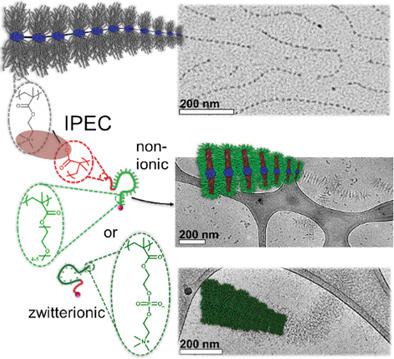当前位置:
X-MOL 学术
›
Macromol. Rapid Commun.
›
论文详情
Our official English website, www.x-mol.net, welcomes your feedback! (Note: you will need to create a separate account there.)
Cylindrical Zwitterionic Particles via Interpolyelectrolyte Complexation on Molecular Polymer Brushes
Macromolecular Rapid Communications ( IF 4.6 ) Pub Date : 2020-09-16 , DOI: 10.1002/marc.202000401 Théophile Pelras 1 , Nonappa 2 , Clare S Mahon 3 , Markus Müllner 1
Macromolecular Rapid Communications ( IF 4.6 ) Pub Date : 2020-09-16 , DOI: 10.1002/marc.202000401 Théophile Pelras 1 , Nonappa 2 , Clare S Mahon 3 , Markus Müllner 1
Affiliation

|
The fabrication of macromolecular architectures with high aspect ratio and well‐defined internal and external morphologies remains a challenge. The combination of template chemistry and self‐assembly concepts to construct peculiar polymer architectures via a bottom‐up approach is an emerging approach. In this study, a cylindrical template—namely a core–shell molecular polymer brush—and linear diblock copolymers (DBCP) associate to produce high aspect ratio polymer particles via interpolyelectrolyte complexation. Induced, morphological changes are studied using cryogenic transmission electron and atomic force microscopy, while the complexation is further followed by isothermal titration calorimetry and ξ‐potential measurements. Depending on the nature of the complexing DBCP, distinct morphological differences can be achieved. While polymers with a non‐ionic block lead to internal compartmentalization, polymers featuring zwitterionic domains lead to a wrapping of the brush template.
中文翻译:

通过分子间聚合物刷上的聚电解质络合的圆柱两性离子粒子。
具有高长宽比和明确定义的内部和外部形态的大分子体系结构的制造仍然是一个挑战。通过自下而上的方法将模板化学和自组装概念相结合以构建特殊的聚合物体系结构是一种新兴的方法。在这项研究中,圆柱形模板(即核-壳分子聚合物刷)和线性二嵌段共聚物(DBCP)通过聚电解质复合形成高纵横比聚合物颗粒。使用低温透射电子和原子力显微镜研究诱导的形态变化,然后通过等温滴定量热法和ξ电位测量进一步跟踪络合。根据复杂DBCP的性质,可以实现明显的形态差异。
更新日期:2020-09-16
中文翻译:

通过分子间聚合物刷上的聚电解质络合的圆柱两性离子粒子。
具有高长宽比和明确定义的内部和外部形态的大分子体系结构的制造仍然是一个挑战。通过自下而上的方法将模板化学和自组装概念相结合以构建特殊的聚合物体系结构是一种新兴的方法。在这项研究中,圆柱形模板(即核-壳分子聚合物刷)和线性二嵌段共聚物(DBCP)通过聚电解质复合形成高纵横比聚合物颗粒。使用低温透射电子和原子力显微镜研究诱导的形态变化,然后通过等温滴定量热法和ξ电位测量进一步跟踪络合。根据复杂DBCP的性质,可以实现明显的形态差异。



























 京公网安备 11010802027423号
京公网安备 11010802027423号